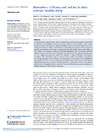Identificador persistente para citar o vincular este elemento:
https://accedacris.ulpgc.es/handle/10553/77927
| Campo DC | Valor | idioma |
|---|---|---|
| dc.contributor.author | de Almeida, André M. | en_US |
| dc.contributor.author | Zachut, Maya | en_US |
| dc.contributor.author | Hernández Castellano, Lorenzo Enrique | en_US |
| dc.contributor.author | Šperanda, Marcela | en_US |
| dc.contributor.author | Gabai, Gianfranco | en_US |
| dc.contributor.author | Mobasheri, Ali | en_US |
| dc.date.accessioned | 2021-03-04T13:08:18Z | - |
| dc.date.available | 2021-03-04T13:08:18Z | - |
| dc.date.issued | 2019 | en_US |
| dc.identifier.issn | 0022-0299 | en_US |
| dc.identifier.uri | https://accedacris.ulpgc.es/handle/10553/77927 | - |
| dc.description.abstract | Increased animal productivity has reduced animal fitness, resulting in increased susceptibility to infectious and metabolic diseases, locomotion problems and subfertility. Future animal breeding strategies should focus on balancing high production levels with health status monitoring and improved welfare. Additionally, understanding how animals interact with their internal and external environment is essential for improving health, fitness, and welfare. In this context, the continuous validation of existing biomarkers and the discovery and field implementation of new biomarkers will enable us to understand the specific physiological process and regulatory mechanisms used by the organism to adapt to different environmental conditions. Thus, biomarkers may be used to monitor welfare and improve management and breeding strategies. In this article, we describe major achievements in the establishment of biomarkers in dairy cows and small ruminants. This review mainly focuses on the physiological biomarkers used to monitor animal responses to, and recovery from, environmental perturbations. We highlight future avenues for research in this field and present a timely positioning document to the scientific community. | en_US |
| dc.language | eng | en_US |
| dc.relation.ispartof | Journal of Dairy Research | en_US |
| dc.source | Journal of Dairy Research [ISSN 0022-0299], v. 86(4), p. 379 - 387 | en_US |
| dc.subject | 3104 Producción Animal | en_US |
| dc.subject.other | Biomarkers | en_US |
| dc.subject.other | Dairy animals | en_US |
| dc.subject.other | Fitness | en_US |
| dc.subject.other | Health | en_US |
| dc.subject.other | Stress | en_US |
| dc.title | Biomarkers of fitness and welfare in dairy animals: healthy living | en_US |
| dc.type | info:eu-repo/semantics/Article | en_US |
| dc.type | article | en_US |
| dc.identifier.doi | 10.1017/S0022029919000803 | en_US |
| dc.identifier.issue | 4 | - |
| dc.investigacion | Ciencias de la Salud | en_US |
| dc.type2 | Artículo | en_US |
| dc.utils.revision | Sí | en_US |
| dc.identifier.ulpgc | No | en_US |
| dc.contributor.buulpgc | BU-VET | en_US |
| dc.description.sjr | 0,594 | |
| dc.description.jcr | 1,628 | |
| dc.description.sjrq | Q2 | |
| dc.description.jcrq | Q2 | |
| dc.description.scie | SCIE | |
| item.grantfulltext | open | - |
| item.fulltext | Con texto completo | - |
| crisitem.author.dept | GIR IUSA-ONEHEALTH 4. Producción y Biotecnología Animal | - |
| crisitem.author.dept | IU de Sanidad Animal y Seguridad Alimentaria | - |
| crisitem.author.dept | Departamento de Patología Animal, Producción Animal, Bromatología y Tecnología de Los Alimentos | - |
| crisitem.author.orcid | 0000-0003-2729-0434 | - |
| crisitem.author.parentorg | IU de Sanidad Animal y Seguridad Alimentaria | - |
| crisitem.author.fullName | Hernández Castellano, Lorenzo Enrique | - |
| Colección: | Artículos | |
Citas de WEB OF SCIENCETM
Citations
23
actualizado el 25-may-2025
Visitas
71
actualizado el 29-ene-2023
Descargas
57
actualizado el 29-ene-2023
Google ScholarTM
Verifica
Altmetric
Comparte
Exporta metadatos
Los elementos en ULPGC accedaCRIS están protegidos por derechos de autor con todos los derechos reservados, a menos que se indique lo contrario.
